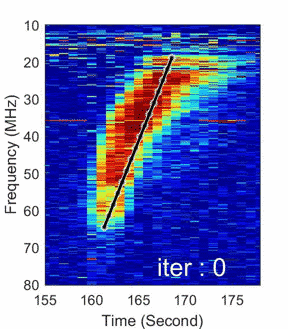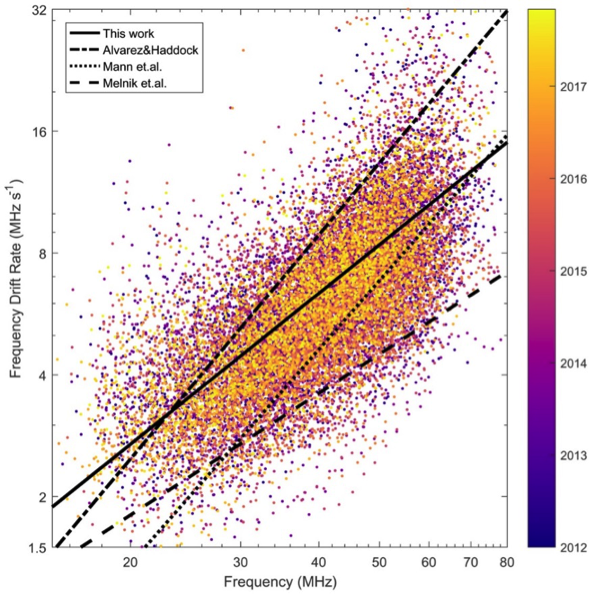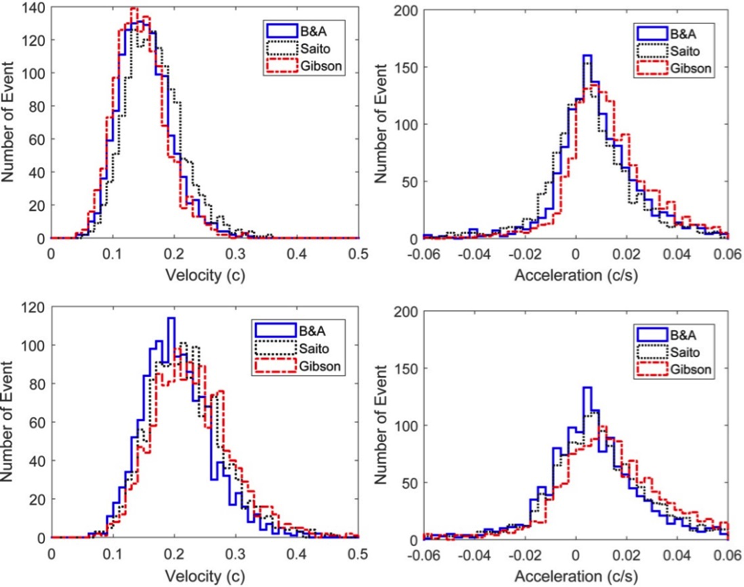Type III radio bursts are the most frequent radio bursts observed from the solar corona, which are generated by weakly relativistic electron beams moving outward along open magnetic field lines from solar active regions. According to the classic plasma emission mechanism (Melrose, 1985), the frequency drift rate of type III bursts depends both on the radial velocity of the exciter electrons and on the gradient of the background electron density distribution with height. We can use the observed frequency drift rate to estimate the speed of electron beams responsible for the generation of type III radio emissions if we have an electron density model for the solar and interplanetary density-distance scale.
In addition, with the increase in the number of instruments for solar observations that have characteristics of high temporary, spatial and frequency resolutions, massive amounts of scientific observation data are produced every day. Automatic methods for event selection and feature finding have great significance for scientific research because of their efficiency in dealing with the massive amounts of available data.
In this work, we design an event recognition-analysis system that can automatically detect solar type III radio burst and can mine information of the burst from the dynamic spectra observed by the Nançay Decameter Array (NDA). We run this system on the NDA data of solar decameter emissions in the frequency range 10-80 MHz between 2012 and 2017, and give a statistical survey of the event number distribution, the frequency drift rate and the speed of electron beams responsible for the generation of the bursts.
Method
We first split the raw data into short segments, subtract the slowly varying background signal, and eliminate the bad data segments. Second, the Hough transform is used to detect and recognize the line segments corresponding type III radio bursts on the spectrum image. From the recognized line segments, we can get the starting time, the starting and stopping frequency of the burst. Finally, a modified active contour model is applied to track the spectrum backbone of a type III bursts so that the frequency drift rates and intensities of the burst can be obtained at different frequency channels. The tracking process is shown in Figure 1.

Figure 1. Backbone tracking process using modified active contour model for a type III burst observed on Apr 22, 2013, at 14:05UT. The white line and the black chain stand for the pre-estimated line and the traced backbone at the iteration, respectively.
Statistical result
Applying this system to the NDA data from 2012 to 2017, we select 1389 single well-isolated bursts whose backbones are well tracked using the modified active contour model. As expected, more events are recognized in years of high solar activity. An interesting finding is that there is a seasonal variation of type III events, namely, the number of events observed between April and October are significantly greater than those in other months in a year. We consider that this seasonal variation may be due to the change of zenith angle of the sun in different seasons.

Figure 2. Scatter plot of the frequency drift rate vs frequency for 1389 simple type III bursts; the data points are color-coded according to the occurrence time of the corresponding event. The solid line indicates the least-squares fitting result in this work. The dot-dashed, dotted, and dashed lines stand for the results in the literature obtained by Alvarez & Haddock (1973a), Mann et al. (1999), and Melnik et al. (2011), respectively.
The frequency drift rate changes with frequency as df/dt = -0.0672 f1.23 from a least-square fitting as shown in Figure 2. We do not find any dependence of the drift rate on the solar activity cycle, indicating that there may be no systematic difference between the height scale of corona electron density in source regions of type III bursts at solar maximum and that at solar minimum, or for the speed of electron beams producing type III bursts.

Figure 3. Distribution of the radio source linear velocity and acceleration derived from three different electron density models of Allen (1947), Saito et al. (1977), and Gibson et al. (1999). Top and bottom panels: results based on the assumptions of fundamental and harmonic wave emission, respectively.
We also derived the linear velocity and acceleration of the exciter electrons for 1389 isolated bursts using three corona density models, as shown in Figure 3. The linear velocities have a mean value of about 0.16c and 0.22c for the fundamental and harmonic assumptions of observed radio emissions, respectively.
The median values of the acceleration distribution are positive for three density models, though the standard deviations are large. This seems to suggest that the exciter electrons experience weak acceleration in the corona (between 80 MHz and 10 MHz). One possible mechanism for the acceleration is that nonthermal electrons injected into the open magnetic field lines from the flare reconnection site have a ring-beam velocity distribution in phase space. When these nonthermal electrons propagate outward from the Sun, the momentum of the ring component that is perpendicular to the field line will transfer to the parallel beam component, supposing the conservation of energy and magnetic momentum.
Data table: A table of the observation time, starting/stopping frequencies, and average frequency drift rates of the 1389 type III bursts is available in electronic form at the CDS via anonymous ftp to cdsarc.u-strasbg.fr (130.79.128.5) or via http://cdsarc.u-strasbg.fr/viz-bin/qcat?J/A+A/618/A165
Based on recent paper: Zhang, P. J., Wang, C. B., Ye, L.: A&A, 618 (2018) A165
References
Allen, C. W.: 1947, MNRAS, 107, 426
Alvarez, H., & Haddock, F.: 1973a, Sol. Phys., 30, 175
Gibson, S. E., Fludra, A., Bagenal, F., et al.: 1999, J. Geophys. Res.: Space Phys., 104, 9691
Mann, G., Jansen, F., Macdowall, R. J., Kaiser, M. L., Stone, R. G.: 1999, A&A, 348, 614
Melnik, V. N., Konovalenko, A. A., Rucker, H. O., et al.: 2011, Sol. Phys., 269,335
Melrose, D. B.: in Solar radiophysics, Cambridge University Press, 1985, p. 177-210
Saito, K., Poland, A. I., & Munro, R. H.: 1977, Sol. Phys., 55, 121
*Full list of authors: PeiJing Zhang, ChuanBing Wang, Lin Ye
